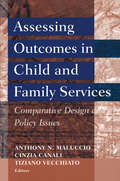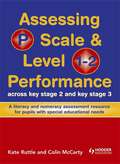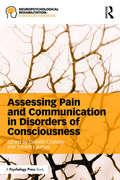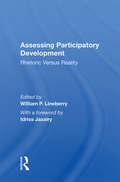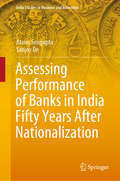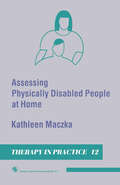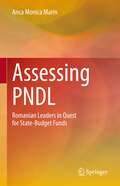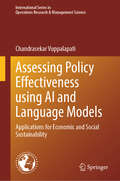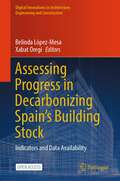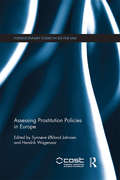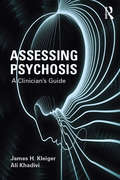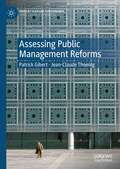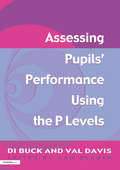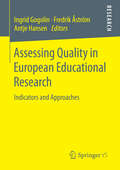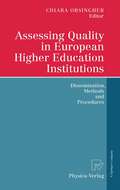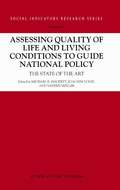- Table View
- List View
Assessing Outcomes in Child and Family Services: Comparative Design and Policy Issues (Modern Applications Of Social Work Ser.)
by Anthony N. MaluccioIn this collective portrait, editors and authors do not attempt to draw systematic, country-by-country comparisons. Given the magnitude of the issues, they believed that it would be inappropriate to paint with too broad a stroke. What they have accomplished, however, is to codify and identify what the participants repeatedly noted in regard to issues and difficulties inherent in conducting outcome evaluation. These include: varying definitions of outcome; complexities in measuring outcomes of particular interventions with different groups of consumers and documenting the effectiveness of the intervention; the tendency to focus on evaluation of process more than outcome; the challenge of involving practitioners in the evaluation task, in part because its value is unclear to them or perceived as distant or untrustworthy; the typical inadequacy of resources available for systematic evaluation; and the need to inject rigor into the design and execution of evaluation projects. The authors demonstrate strong conviction about sharing research expertise across national boundaries; learning through each other how to cope with organizational impediments to cross-national collaboration; and strengthening the interaction between practice and research. Their contributions suggest that there is wide interest in pursuing cross-national collaboration. In recent years, largely in response to demands by their funding sources for accountability, assessment of performance, and cost effectiveness, researchers in human services have been devoting increased attention to outcome evaluation. Limited attention, however, has been given to the findings of evaluation studies conducted in different countries. The present volume has been organized and edited to address the task of learning from outcome research across the world. Its goal, an extension of a major goal of the human services in any one country, is to improve life chances of vulnerable children and youth.
Assessing Outcomes in Child and Family Services: Comparative Design and Policy Issues
by Anthony N. MaluccioIn this collective portrait, editors and authors do not attempt to draw systematic, country-by-country comparisons. Given the magnitude of the issues, they believed that it would be inappropriate to paint with too broad a stroke. What they have accomplished, however, is to codify and identify what the participants repeatedly noted in regard to issues and difficulties inherent in conducting outcome evaluation. These include: varying definitions of outcome; complexities in measuring outcomes of particular interventions with different groups of consumers and documenting the effectiveness of the intervention; the tendency to focus on evaluation of process more than outcome; the challenge of involving practitioners in the evaluation task, in part because its value is unclear to them or perceived as distant or untrustworthy; the typical inadequacy of resources available for systematic evaluation; and the need to inject rigor into the design and execution of evaluation projects. The authors demonstrate strong conviction about sharing research expertise across national boundaries; learning through each other how to cope with organizational impediments to cross-national collaboration; and strengthening the interaction between practice and research. Their contributions suggest that there is wide interest in pursuing cross-national collaboration. In recent years, largely in response to demands by their funding sources for accountability, assessment of performance, and cost effectiveness, researchers in human services have been devoting increased attention to outcome evaluation. Limited attention, however, has been given to the findings of evaluation studies conducted in different countries. The present volume has been organized and edited to address the task of learning from outcome research across the world. Its goal, an extension of a major goal of the human services in any one country, is to improve life chances of vulnerable children and youth.
Assessing P Scale and Level 1-2 Performance Across Key Stage 2 and Key Stage 3: A Literacy and Numeracy Assessment Resource for Pupils with Special Educational Needs (PDF)
by Kate Ruttle Colin McCartyTeachers of pupils with special educational needs are now expected to conduct and report an annual National Curriculum assessment, as well as to track and report progress termly in line with IEP targets. For those pupils functioning below NC level 1, the P (Performance) Scales provide the official eight-point assessment scale - but this is so far removed from mainstream classroom experience that many SENCOs, teachers and teaching assistants at KS2 and KS3 working with 'included' pupils have real difficulty in making P-level assessments.
Assessing Pain and Communication in Disorders of Consciousness (Neuropsychological Rehabilitation: A Modular Handbook)
by Steven Laureys Camille ChatelleRecent advances in medicine for resuscitation and care have led to an increased number of patients that survive severe brain damage but who are poorly responsive and non-communicative at the bedside. This has led to a striking need to better characterize, understand, and manage this population who present a real challenge for the assessment of pain and for planning treatment. This edited collection provides clinicians with a guide to recent developments in research on pain perception and assessment, and the detection of consciousness and communication in patients with disorders of consciousness (DOC). With contributions from leading global researchers, the book gives an overview of issues concerning the assessment of pain. It also covers the development of suitable tools both to improve pain management and to detect consciousness and communication in these patients, to influence their prognosis and treatment, and their quality of life. Methodological and ethical issues concerning the implication for future research are also considered. The book will be an invaluable guide for clinicians, medics and therapists working in rehabilitation and acute care, particularly in the demanding field of pain perception, pain assessment and detection of consciousness and communication in patients with DOC. It will also be useful for students and researchers in neuropsychology and medical sciences.
Assessing Pain and Communication in Disorders of Consciousness (Neuropsychological Rehabilitation: A Modular Handbook)
by Steven Laureys Camille ChatelleRecent advances in medicine for resuscitation and care have led to an increased number of patients that survive severe brain damage but who are poorly responsive and non-communicative at the bedside. This has led to a striking need to better characterize, understand, and manage this population who present a real challenge for the assessment of pain and for planning treatment. This edited collection provides clinicians with a guide to recent developments in research on pain perception and assessment, and the detection of consciousness and communication in patients with disorders of consciousness (DOC). With contributions from leading global researchers, the book gives an overview of issues concerning the assessment of pain. It also covers the development of suitable tools both to improve pain management and to detect consciousness and communication in these patients, to influence their prognosis and treatment, and their quality of life. Methodological and ethical issues concerning the implication for future research are also considered. The book will be an invaluable guide for clinicians, medics and therapists working in rehabilitation and acute care, particularly in the demanding field of pain perception, pain assessment and detection of consciousness and communication in patients with DOC. It will also be useful for students and researchers in neuropsychology and medical sciences.
Assessing Participatory Development: Rhetoric Versus Reality
by William P. LineberryThis book was shaped by ten years of International Fund for Agricultural Development's experience on innovative approaches to people's participation in development. Its critical assessment of the participatory approach explains how it works, its benefits and the pitfalls it harbours for the unwary.
Assessing Participatory Development: Rhetoric Versus Reality
by William P. LineberryThis book was shaped by ten years of International Fund for Agricultural Development's experience on innovative approaches to people's participation in development. Its critical assessment of the participatory approach explains how it works, its benefits and the pitfalls it harbours for the unwary.
Assessing Performance of Banks in India Fifty Years After Nationalization (India Studies in Business and Economics)
by Atanu Sengupta Sanjoy DeThis book assesses the performance of banks in India over the past several decades, and discusses their current status after fifty years of nationalization. The performance of different categories of banks is evaluated by employing both the traditional ratio analysis and more sophisticated efficiency techniques. The book also explores the market conditions under which Indian banks operate. Going beyond a formal banking study, the book also investigates the causes of the widespread presence of informal credit in parallel to its formal banking counterpart. This approach makes it more comprehensive, unique and closer to the real world.After 50 years of nationalization, India’s banking sector is at a crossroads, given the huge and unabated non-performing assets and talks of consolidation. This book, encompassing both the formal and the predominantly ‘trust-based’ informal credit system, provides essential insights for bankers and policymakers, which will be invaluable in their endeavours to implement meaningful changes. It may also spark new research in the fields of banking performance and efficiency analysis. Lastly, the book not only has significant implications for students of economics, banking, finance and management, but also offers an important resource to support training courses for banking personnel in India.
Assessing Physically Disabled People At Home (Therapy in Practice Series)
by Kathleen MaczkaIn the current era of cost awareness and the pressure to free hospital beds as rapidly as possible, coupled with the move towards community care, there is increasing emphasis on returning and main taining disabled people in the community. Often, many health and welfare workers are involved in this process. Occupational therapists however have a particular role to play. Their training is such that they are able to assess and treat the physical, psychological and social aspects of a disabling condition. This enables them to help disabled people to achieve their maximum ability in the environment in which they live. Whether the occupational therapist is hospital or community based, employed by the health or social service depart ment, her caseload is often vast. The occupational therapist may specialize in a particular age group or disability, but it is more likely that she will have to work with a wide age range from the very young to the very old. Assessment of needs and the subsequent provision of equipment and adaptations is the greater part of the OT's job. Other aspects include counselling the disabled person and his family and planning future intervention must often, however reluctantly, be given a low priority. In spite of staff shotages occupa tional therapists are frequently called on to provide the client and other groups of workers with advice and information on all aspects of living with any disability.
Assessing PNDL: Romanian Leaders in Quest for State-Budget Funds
by Anca Monica MarinThis book provides an in-depth analysis of the distribution of funds by the National Program for Local Development (PNDL), Romania’s largest state funded budget program. It provides an objective assessment of the way state budget funds are allocated at the level of county councils and municipalities in urban and rural areas. It covers allocations of the second phase of program implementation, namely the reformed PNDL II 2017-2020, which has double the volume of funds than the previous phase. Using a conceptual framework at the crossroads of sociology, public management, and public finance, this book provides necessary context for the complex funding environment of first and second tier level institutions in Romania.A comprehensive study on public administration, politicization, and development imbalances, this book will be of interest to researchers in public administration, sociology, and public finance, as well as politicians, civil servants, consultants, decision-makers, and representatives of responsible institutions with EU funds at national and EU level.
Assessing Policy Effectiveness using AI and Language Models: Applications for Economic and Social Sustainability (International Series in Operations Research & Management Science #354)
by Chandrasekar VuppalapatiThis volume uses advanced machine learning techniques to analyze government communication to evaluate policy effectiveness. The book develops policy effectiveness foundation models by cohorting historical budget policies with statistical models which are built on well reputed data sources including economic events, macroeconomic trends, and ratings and commerce terms from international institutions. By signal mining policies to the economic outcome patterns, the book aims to create a rich source of successful policy insights in terms of their effectiveness in bringing development to the poor and underserved communities to ensure the spread of wealth, social wellbeing, and standard of living to the common denomination of society rather than a selected quotient. Enabling academics and practitioners across disciplines to develop applications for effective policy interventions, this volume will be of interest to a wide audience including software engineers, data scientists, social scientists, economists, and agriculture practitioners.
Assessing Progress in Decarbonizing Spain’s Building Stock: Indicators and Data Availability (Digital Innovations in Architecture, Engineering and Construction)
by Belinda López-Mesa Xabat OregiThis open access book delves into the topic of monitoring the effectiveness of building renovation policies within the European Union (EU) using indicators. Given the substantial environmental impact of existing buildings on energy consumption and greenhouse gas emissions, decarbonizing them is imperative for achieving climate neutrality in Europe. The use of indicators for monitoring decarbonization progress and evaluating policies emerges as a valuable tool, ensuring the efficiency, effectiveness, and alignment of building renovation policies with broader sustainability and climate objectives. Additionally, this approach facilitates evidence-based decision-making, promotes accountability by Member States (MSs), supports the realization of long-term goals, and actively involves the public in these vital initiatives. The European Commission is actively engaged in this realm, releasing a framework of optional indicators in 2019 and subsequently refining it during the review of the Energy Performance of Buildings Directive. The evolving framework seeks to encompass both mandatory and optional indicators, posing greater challenges for EU MSs in monitoring the impact of their national building renovation policies and the progress of decarbonizing their building stocks. This book offers insights into these developing indicator frameworks, assesses the availability and quality of data in the case of Spain, and suggests areas of improvement and innovative approaches using emerging technologies to enhance data. The target audience includes diverse stakeholders such as central government administrations, regional and municipal authorities, data-collecting institutions, urban planners, researchers, and citizens interested in comprehending the impact of building renovation. By addressing this broad audience, the book aims to foster a more inclusive and well-informed discussion on building renovation and the decarbonization of the European building stock.
Assessing Prostitution Policies in Europe (Interdisciplinary Studies in Sex for Sale)
by Hendrik Wagenaar Synnøve Økland JahnsenOnce again, prostitution occupies a prominent position on public and political agendas, both nationally and internationally. A topic of concern and interest within social and academic realms, it is a highly moralised, contested issue that is at the centre of heated and drawn-out debates. With each chapter dedicated to a separate country and written by a national authority on the subject, Assessing European Prostitution Policies seeks to explore how prostitution is regulated in 21 European countries, thus drawing out important implications for an effective and humane prostitution policy. Indeed, this innovative volume brings together systematic accounts of how national and local forms of governance influence the commercial market for sex as well as the lives of sex workers and third parties. All chapters cover the history of prostitution policy, national laws regulating prostitution, policy formulation and implementation, the national discourse on prostitution, the gap between national and local regulation, the impact of policy on the lives and rights of sex workers, and sex worker advocacy organizations. In addition to this, the authors examine and highlight how immigration, labour, fiscal and welfare law have as much impact on the sex trade as designated prostitution law. A unique interdisciplinary title that is comprehensive in its coverage, Assessing European Prostitution Policies will appeal to undergraduate and postgraduate students, postdoctoral researchers, sex worker advocacy organisations and policy makers interested in fields such as Sexuality and Prostitution, Public Policy, Criminology and Gender Studies.
Assessing Prostitution Policies in Europe (Interdisciplinary Studies in Sex for Sale)
by Hendrik Wagenaar Synnøve Økland JahnsenOnce again, prostitution occupies a prominent position on public and political agendas, both nationally and internationally. A topic of concern and interest within social and academic realms, it is a highly moralised, contested issue that is at the centre of heated and drawn-out debates. With each chapter dedicated to a separate country and written by a national authority on the subject, Assessing European Prostitution Policies seeks to explore how prostitution is regulated in 21 European countries, thus drawing out important implications for an effective and humane prostitution policy. Indeed, this innovative volume brings together systematic accounts of how national and local forms of governance influence the commercial market for sex as well as the lives of sex workers and third parties. All chapters cover the history of prostitution policy, national laws regulating prostitution, policy formulation and implementation, the national discourse on prostitution, the gap between national and local regulation, the impact of policy on the lives and rights of sex workers, and sex worker advocacy organizations. In addition to this, the authors examine and highlight how immigration, labour, fiscal and welfare law have as much impact on the sex trade as designated prostitution law. A unique interdisciplinary title that is comprehensive in its coverage, Assessing European Prostitution Policies will appeal to undergraduate and postgraduate students, postdoctoral researchers, sex worker advocacy organisations and policy makers interested in fields such as Sexuality and Prostitution, Public Policy, Criminology and Gender Studies.
Assessing Psychosis: A Clinician's Guide
by James H. Kleiger Ali KhadiviAssessing Psychosis: A Clinician’s Guide offers both a practical guide and rich clinical resource for a broad audience of mental-health practitioners seeking to sharpen their understanding of diagnostic issues, clinical concepts, and assessment methods that aid in detecting the presence of psychotic phenomena. Practicing psychiatrists, psychologists, social workers, and psychiatric nurses will find this a valuable resource for clinical practice, training, and teaching purposes.
Assessing Psychosis: A Clinician's Guide
by James H. Kleiger Ali KhadiviAssessing Psychosis: A Clinician’s Guide offers both a practical guide and rich clinical resource for a broad audience of mental-health practitioners seeking to sharpen their understanding of diagnostic issues, clinical concepts, and assessment methods that aid in detecting the presence of psychotic phenomena. Practicing psychiatrists, psychologists, social workers, and psychiatric nurses will find this a valuable resource for clinical practice, training, and teaching purposes.
Assessing Psychosis: A Clinician's Guide
by James H. Kleiger Ali KhadiviThis second edition of Assessing Psychosis: A Clinician’s Guide offers both a practical guide and rich clinical resource for a broad audience of mental health practitioners seeking to sharpen their understanding of diagnostic issues, clinical concepts, and assessment methods that aid in detecting the presence of psychotic phenomena. Case vignettes deepen clinical understanding, and all chapters include a summary of practical clinical guidelines. This new edition includes two new chapters and updated diagnostic criteria considering the new DSM-5-TR. Practicing psychiatrists, psychologists, social workers, psychiatric nurses and students will find this a valuable resource for clinical practice, training, and teaching purposes.
Assessing Psychosis: A Clinician's Guide
by James H. Kleiger Ali KhadiviThis second edition of Assessing Psychosis: A Clinician’s Guide offers both a practical guide and rich clinical resource for a broad audience of mental health practitioners seeking to sharpen their understanding of diagnostic issues, clinical concepts, and assessment methods that aid in detecting the presence of psychotic phenomena. Case vignettes deepen clinical understanding, and all chapters include a summary of practical clinical guidelines. This new edition includes two new chapters and updated diagnostic criteria considering the new DSM-5-TR. Practicing psychiatrists, psychologists, social workers, psychiatric nurses and students will find this a valuable resource for clinical practice, training, and teaching purposes.
Assessing Public Management Reforms (Understanding Governance)
by Jean-Claude Thoenig Patrick GibertThis book examines why many ambitious public management policies do not materialize. Comprehensive reforms do not generate relevant and lasting changes. Yet some evolutions may occur that actually improve the efficiency level inside public administrations. The book identifies how and why such processes may occur. It explores an innovative approach to the way reform policies inside the public sector are assessed. The opening chapters examine the contributions of different disciplines to the study of change in the public sector, before proposing a framework to better understand management developments. The book then reviews eight crosscutting central government programmes successively launched since the late 1960s, examines how these programmes were designed and constructed, and analyses the ways in which three toolkits are appropriated: dashboards and indicators, cost-benefit analysis, and ex post evaluation. The final chapters examine the links between the development of agencification and the way in which central government proceeds to implement it, and demonstrate why and how the structure of human resources is crucial for initiating change processes. Together, the book proposes lessons for public practitioners as well as for academic purposes.
Assessing Pupil's Performance Using the P Levels
by Val Davis Di BuckThis book has been designed to provide guidance for special and mainstream schools in the assessment of pupils' learning from Level P1 up to and including National Curriculum Level 1A. It contains exemplification of the descriptions of attainment for reading, writing and the three strands of mathematics identified in Planning, Teaching and Assessing the Curriculum for Pupils with Learning Difficulties produced by the QCA. The book provides clarification of the performance criteria, through illustrative examples, and supports accurate and consistent teacher assessment of pupils working at these levels. It enables effective monitoring of attainment and progression, which will support the target setting process, and demonstrates how assessments can be used to inform next steps in learning. The authors include examples from special and mainstream schools on reading, writing and mathematics. The book also contains photocopiable proformas for your own use.SENCOs and teachers in special and mainstream schools should find this book helps them to chart the progress of their pupils' learning very effectively.
Assessing Pupil's Performance Using the P Levels
by Val Davis Di BuckThis book has been designed to provide guidance for special and mainstream schools in the assessment of pupils' learning from Level P1 up to and including National Curriculum Level 1A. It contains exemplification of the descriptions of attainment for reading, writing and the three strands of mathematics identified in Planning, Teaching and Assessing the Curriculum for Pupils with Learning Difficulties produced by the QCA. The book provides clarification of the performance criteria, through illustrative examples, and supports accurate and consistent teacher assessment of pupils working at these levels. It enables effective monitoring of attainment and progression, which will support the target setting process, and demonstrates how assessments can be used to inform next steps in learning. The authors include examples from special and mainstream schools on reading, writing and mathematics. The book also contains photocopiable proformas for your own use.SENCOs and teachers in special and mainstream schools should find this book helps them to chart the progress of their pupils' learning very effectively.
Assessing Quality in European Educational Research: Indicators and Approaches
by Ingrid Gogolin Fredrik AströmCompetition-based models for research policy and management have an increasing influence throughout the research process, from attracting funding to publishing results. The introduction of quality control methods utilizing various forms of performance indicators is part of this development. The authors presented in this volume deal with the following questions: What counts as ‘quality’ and how can this be assessed? What are the possible side effects of current quality control systems on research conducted in the European Research Area, especially in the social sciences and the humanities?
Assessing Quality in European Higher Education Institutions: Dissemination, Methods and Procedures
by Chiara OrsingherEuropean higher education institutions are facing in these last years a number of relevant political and social changes that have asked for more transparency, accountability, comparability and legitimacy of degrees. In light of these new challenges, the great majority of universities have responded by implementing quality assurance processes, either through evaluation or through accreditation. This book collects the evaluation and accreditation experiences gathered by higher education institutions in Finland, France, Germany, Italy, the Netherlands, Spain, the United Kingdom and Sweden. It provides a synthetic picture of the present state of quality assurance practices in Europe and offers a few lessons for a future European dimension of quality assurance.
Assessing Quality of Life and Living Conditions to Guide National Policy: The State of the Art (Social Indicators Research Series #11)
by ValerieMøller JoachimVogel Michael R. HagertyThis book is a useful "how to" book for researchers and government offices wanting to start or improve their own QOL survey, and contains "best practices" from all over the world. It is a valuable resource for researchers, policy and for those wishing to effect changes in public policy.
Assessing Race, Ethnicity and Gender in Health
by Sana LoueThis book deals specifically with the historical basis for use of terms in race, gender, ethnicity, sex and sexual orientation. It brings much needed clarity to the debate by identifying the ethical issues as well as the technical challenges inherent in measuring these elusive concepts. The author expands on her work begun in Gender, Ethnicity, and Health Research by paralleling the evolution of racial and sexual categories with the development of health research. In addition, the book provides a salient guide to assessment tools currently used in measuring racial and sexual constructs, identity, and experience.
